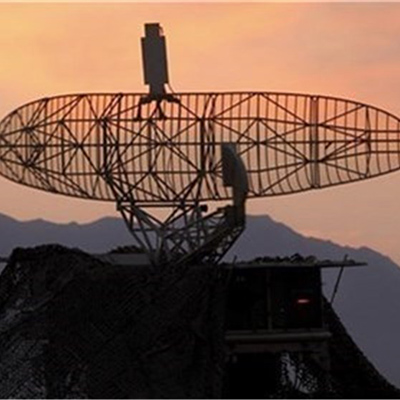Warfare
Radar
Written by: Mohsen Shirmuhammad,
Translated by: Hadi Qorbanyar
94 دورہ
Radar is a device used for detecting and identifying aerial targets such as airplanes and helicopters. Radar technology proved essential during the Iran–Iraq War. The term “RADAR” was first used as an acronym for “Radio Detection and Ranging”, referring to a system that uses radio waves to determine the distance (ranging) and direction.[1]
Radar technology is the foundation of aerospace and air defense systems. Modern air defense systems can not operate effectively without radar.[2] Robert Watson-Watt, who is known as the father of radar, designed the first radar in 1938. It had a range of about 200 miles. Radar was developed and employed in World War II at ground bases as well as on aircraft and ships.[3]
The history of radar in Iran dates back to 1957, when several technical officers were sent to the United Kingdom for radar training. Subsequently, a radar training center was established within the Air Force Training Brigade.[4] In 1958, Tonic radars (UK-made) were installed at Doshan-Tappeh and Qaleh-Morghi airports; in 1960, Hydra radars (UK-made) were deployed in Tabriz, Babolsar, Mashhad, and Shahrabad in Khorasan Province; in 1966–67, FPS-100 radars (US-made) were set up in Hamadan and Dezful; and in 1971, further systems were installed in Bandar Abbas, Bushehr, Jask, and Kish. In 1969, AR-5 radars (UK-made) were placed in Tabriz; in 1974, GPS-11 radars (US-made) were deployed in Abdanan and Bandar Taheri in Bushehr (Siraf); and in 1976, ADS-4 radars (US-made) were installed in Karaj and Bandar Abbas, accompanied by seven GPS-11 tactical radars.[5]
Various aircraft in Iran were also equipped with radars. For instance, the F-14 fighter was fitted with the AWG-9 radar, which could simultaneously track 24 targets[6] and function as a small airborne warning and control system (mini-AWACS).[7] Missile defense sites also had their own radars. For example, the Hawk missile system was equipped with two radars for detecting both high- and low-altitude targets, as well as a radar for navigation and missile tracking.[8]
On the other hand, until 1966, Iraq’s air force radar system consisted only of one ground control unit based in Baghdad and three early-warning units in the northern parts of the country. Over time, these units expanded, and by 1980, Iraq’s radar network had developed into a four-zone system, comprising nearly 30 early-warning sites and more than 116 advanced tactical radars supplied by the Soviet Union and several European countries.[9] Iraq’s air defense was equipped with Soviet-made P-series radars, Polish-made Nysa radars, UK-made Marconi radars, and several French systems.[10]
On the eve of the Iran–Iraq War, twelve radar stations provided Iran’s radar coverage. In addition, six ADS-4 radars had been purchased, and their deployment sites were prepared; however, in 1978, during their final year in Iran, technicians from the American manufacturer Westinghouse refused to activate the systems.[11]
With the outbreak of the war in 1980, one of the most significant radar-related events was the case of the Dehloran radar. On September 29, 1980, it was completely destroyed by Iraq and subsequently destroyed by Iranian aircraft to prevent the enemy from accessing its operational and technical data. This radar had been the primary system covering Khuzestan Province. On October 13, 1980, Iran deployed a GPS radar on the heights overlooking the Dez Dam. By November 11, the system was operational, restoring part of the lost capability.[12]
Regional radar installations played a significant role in supporting operations during the liberation of Khuzestan. For instance, the radar units in Bushehr, Sarbandar, and Behbahan played a role in Operation Thamen al-Aemmah (as) (the breaking of the Abadan siege), while those positioned at Dez Dam, Mosharrahat near Ahvaz, Sarbandar in Mahshahr, Bushehr, and Behbahan contributed to the Operation Tariq al-Quds (the liberation of Bostan and western Khuzestan).[13]
Throughout the war, the Iraqi air defense system repeatedly failed against Iranian pilots. A key factor in these successes was the contribution of Iranian fighter control officers and radar site personnel, who played a vital role in directing air operations.[14]
Iraqi aircraft frequently employed Kh-28 anti-radar missiles to target Hawk missile radars[15] as well as radar sites near Iraq’s border, including those at Abdanan, Dez Dam, Ahvaz, and Bandar Imam Khomeini. For example, on May 23, 1985, Iraq attacked the Bushehr radar facility, causing severe damage to its direction-finder antenna, though it was later repaired. During the period it was out of service, a GPS-11 radar stationed at Hashemabad (Isfahan) was transferred to Bushehr and put into operation. Likewise, the GPS-11 radar facility at Abdanan came under attack on June 5, 1985, and was partly destroyed.[16]
Because of the limited low-altitude radar coverage across the Iranian plateau, observers were stationed near sensitive locations to prevent surprise attacks.[17] By the final days of the war, a nationwide visual observation system was employed as a supplement to radar coverage, especially at low altitudes.[18]
One of Iran’s notable wartime innovations was its ability to issue missile strike alerts across multiple cities, despite the national radar network’s inability to detect or track incoming missiles. By comparing observer reports with signals from listening posts, radar stations responded quickly to pinpoint the targeted city and trigger its alarm.[19]
In countering Iraq’s Exocet missiles, Iran began deploying radar reflectors.[20] Mounted on small boats, these devices would send out misleading signals to divert the missiles.[21] In addition, naval helicopters dispersed chaff, which also helped misguide incoming Exocets.[22] Chaff was small strips of aluminum released into the air to create false radar echoes.[23]
From late 1981, Iraq upgraded its fleet with Soviet X-28 anti-radar missiles carried by Sukhoi-22 aircraft and French A-3-37 missiles mounted on Mirage fighters.[24] With these capabilities, Iraq increasingly focused on detecting and destroying Iranian radars in the south. This caused significant damage to Iran’s radar capacity in the later years of the war.[25] For example, on February 12, 1984, the Dezful radar was targeted.[26]
France also supplied Iraq with Rasit ground-surveillance radars, which the Iraqi army frequently used to track Iranian troop movements.[27]
Due to international sanctions, Iran was unable to purchase new radar systems or receive technical assistance during the eight years of the war.[28] As a result, the air defense network faced severe shortages of spare parts for long-range radars. Therefore, Iranian forces redeployed remaining mobile radars to Behbahan, Zahedan, Chabahar, Hashemabad, and Bandar Taheri, operating them on a rotating and unpredictable basis to minimize the threat from Iraqi anti-radar missiles.[29]
On July 26, 1988 (the final days of the war), Iraqi aircraft twice struck the Subashi radar site in Hamadan with anti-radar missiles. This facility had been responsible for covering the operational zone. The attack led to the martyrdom of its commander, Major Farhad Dastanbou, along with 18 personnel.[30]
Throughout the eight years of the Iran–Iraq War, Iran’s air defense operational units, through an extensive network of radars and observation posts, detected tens of thousands of enemy air raids. They succeeded in downing 605 enemy aircraft and neutralizing 24,862 attempted strikes through tactical countermeasures.[31]
After the war, tactical radar units began rebuilding the damaged radar systems.[32] Advanced JY-14 radars were installed in Chabahar (1991), Dezful (1992), and Qaleh-Morghi (1993). By 2001, national radar stations were also established in Chuka (Talesh) and Moghan.[33]
Meanwhile, Iran steadily expanded its radar capabilities, laying the groundwork for future self-reliance. Today, around 40 domestic radar systems are operational, including the Kashef, Matla al-Fajr, Kavosh, and Sepehr, the latter with a range of up to 4,000 kilometers.[34]
[1] Shirmuhammad, Mohsen, Cheshman-e Oqab: Hemaase-ye Gardan-e 11 Shenasaayi-e Taaktiki-ye Niru-ye Havaei va Amalyat-e Aksbardari-e Havaei dar Dafa Muqaddas (Eagle Eyes: The Epic of Tactical Reconnaissance Battalion 11 and Aerial Photography Operations in the Sacred Defense), Tehran: Markaz-e Entesharat-e Rahbordi-ye NAHAJA, 1396, p. 38.
[2] Gholami, Baratali, Pishgaman-e Sanat-e Radar dar Iran (Pioneers of Radar Technology in Iran), Tehran: Iran-e Sabz, 1397, p. 1.
[3] Ibid., Pp. 42–43.
[4] Goruh-e Ostadan-e Maaref-e Jang, Maaref-e Jang (War Studies), Tehran: Entesharat-e Iran-e Sabz, 1393, p. 360.
[5] Ibid., p. 361.
[6] Zeynali, Nasrollah, Amad va Poshtibani Havaei dar Defa Muqaddas: Az Aghaz ta Shoru Jang-e Tahmili (Air Logistics in the Sacred Defense: From the Beginning to the Start of the Imposed War), Vol. 1, Tehran: Markaz-e Entesharat-e Rahbordi-ye NAHAJA, 1394, p. 223.
[7] Cordesman, Anthony and Abraham Wagner, Dars-haye Jang-e Modern: Jang-e Iran va Araq (Lessons of Modern War: The Iran–Iraq War), Vol. 2, Trans. Hussain Yekta, Tehran: Nashr-e Marz-o-Boom, 1390, p. 410.
[8] Babamuhammoudi, Mahdi, Shekarchi-ye Doshanbeh: Goftogu ba Sarhang-e Padafand Khosrow Jahani, Bakhsh-e Nokhost (The Monday Hunter: Interview with Colonel Khosrow Jahani, Part One), Mahanameh-ye Sanaye-e Havaei, No. 291, Aban 1394, p. 9.
[9] Goruh-e Moallefin-e Tarikh-e Defa Havaei, Tarikh-e Nabardhaye Havaei-ye Defa Muqaddas, Ta Aghaz-e Tahajom-e Saraasari-ye Araq (History of Aerial Battles in the Sacred Defense: Until the Start of Iraq’s Full-Scale Invasion), Vol. 1, Tehran: Markaz-e Entesharat-e Rahbordi-ye NAHAJA, 1393, p. 344.
[10] Ibid., p. 347.
[11] Gholami, Baratali, Padafand-e Havaei: Seir-e Towsee va Takamol (Air Defense: Development and Evolution), Vol. 1, Tehran: Entesharat-e Iran-e Sabz, 1399, Pp. 38–39, 104.
[12] Ibid., Pp. 100–101, 120.
[13] Namaki, Ali-Reza, Niroo-ye Havaei dar Defa Muqaddas (The Air Force in the Sacred Defense), Tehran: Iran-e Sabz, 1389, Pp. 178, 212.
[14] Moroori bar Amalkard-e Padafand-e Havaei dar Doran-e Defa Muqaddas (Reviewing the Air Defense Performance during the Sacred Defense), www.aja.ir
[15] Namaki, Ali-Reza, Ibid., Pp. 220–221.
[16] Gholami, Baratali, Padafand-e Havaei: Seir-e Towsee va Takamol (Air Defense: Development and Evolution), Vol. 1, p. 107.
[17] Ibid., p. 108.
[18] Ibid., p. 109.
[19] Ibid.
[20] Woods, Kevin M. et al., Jang-e Iran va Araq az Didgah-e Farmandehan-e Saddam (The Iran–Iraq War from Saddam’s Commanders’ Perspective), Trans. Abdolmajid Heidari, Tehran: Nashr-e Marz-o-Boom, 1393, p. 349.
[21] Ibid., p. 350.
[22] Shirmohammad, Mohsen, Eskaderan-e Zede-Sathi-ye Balgard-e AB-212-e Havadarya dar Defa Muqaddas: Bakhsh-e Dovvom (The AB-212 Anti-Surface Helicopter Squadron in the Sacred Defense: Part Two), Mahanameh-ye Sanaye-e Havaei, No. 319, Tir–Mordad 1398, p. 7.
[23] Shirmohammad, Mohsen, Bar Faraz-e Daryaha: Negahi be Tarikhe Havadarya va Hemaase-ye Eskadranhaaye Havanav, Balgard va Baal-e Saabet dar Jang-e Tahmili (Above the Seas: A Look at the History of Naval Aviation and the Heroism of Hovercraft, Helicopter, and Fixed-Wing Squadrons in the Imposed War), Tehran: Daftar-e Pazhuheshhaye Nazari va Motaleat-e Rahbordi-ye NEDAJA, 1400, p. 180.
[24] Gholami, Baratali, Padafand-e Havaei: Seir-e Towsee va Takamol (Air Defense: Development and Evolution), Vol. 1, p. 158.
[25] Habibi, Nikbakhsh and Ali Gholami, Defa Muqaddas va Qodrat-e Havaei (The Sacred Defense and Air Power), Tehran: Markaz-e Entesharat-e Rahbordi-ye NAHAJA, 1397, p. 71.
[26] Gholami, Baratali, Padafand-e Havaei: Seir-e Towsee va Takamol (Air Defense: Development and Evolution), Vol. 1, p. 171.
[27] Razit; Radar-e Ehdayi-ye Faranseh be Saddam (Rasit: France’s Gifted Radar to Saddam), Khabargozari-ye Defa Muqaddas, 28 Tir 1397,
https://defapress.ir/fa/news/300349
[28] Gholami, Baratali, Padafand-e Havaei: Seir-e Towsee va Takamol (Air Defense: Development and Evolution), Vol. 1, p. 296.
[29] Ibid., p. 107.
[30] Goruh-e Moallefin-e Tarikh-e Defa Havaei, Tarikh-e Nabardhaye Havaei-ye Defa Muqaddas, Ta Aghaz-e Tahajom-e Saraasari-ye Araq (History of Aerial Battles in the Sacred Defense: Until the Start of Iraq’s Full-Scale Invasion), Vol. 1, p. 345.
[31] Moroori bar Amalkard-e Padafand-e Havaei dar Doran-e Defa Muqaddas (Reviewing the Air Defense Performance during the Sacred Defense), www.aja.ir
[32] Gholami, Baratali, Pishgaman-e Sanat-e Radar dar Iran (Pioneers of Radar Technology in Iran), p. 37.
[33] Goruh-e Ostadan-e Maaref-e Jang, Maaref-e Jang (War Studies), Tehran: Entesharat-e Iran-e Sabz, 1393, p. 361.
[34] 40 Model Radar-e Irani; Cheshman-e Hamisheh Bidar-e Niroohaye Mosallah (40 Iranian Radar Types: The Ever-Watchful Eyes of the Armed Forces), Mashregh News, 29 Mehr 1393, www.mashreghnews.ir/news/356069



